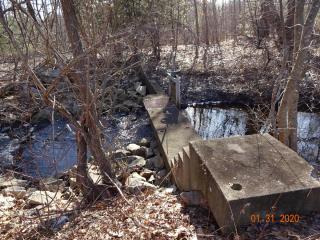SNUP Dam Removal

The Old Swamp River is a perennial river running 4.4 miles from its headwaters in Rockland to the South Cove of Whitman’s Pond. The River is designated a cold-water fish resource, meaning it has a state recognized population of native brook trout. It also provides spawning grounds for river herring that annually migrate up the Back River and into Whitman’s Pond.
The Sediment Nutrient Uptake Pond (SNUP) consists of a dam on the Od Swamp River that was designed to divert river water into a series of small treatment ponds before discharging back into the Old Swamp River just before it reaches the South Cove of Whitman’s Pond. The SNUP was constructed in the late 1980s with the goal of reducing phosphorus and other nutrients entering Whitman’s Pond via the Old Swamp River. This was based on a 1986 study by Metcalf and Eddy that concluded approximately 60% of phosphorus loading into Whitman’s Pond was entering through the River. The SNUP consists of a dam on the Old Swamp River that, when functioning as designed, diverts river water into a sediment basin for the settling of suspended sediments, followed by a nutrient uptake pond for the removal of phosphorus and other nutrients. The project was considered experimental at the time. The SNUP is located on the south side of Libbey Industrial Parkway, on the west side of the Old Swamp River, approximately a quarter-mile upstream of the river’s confluence with the South Cove of Whitman’s Pond.
Unfortunately the SNUP never functioned fully as intended and required frequent maintenance of the sediment basins to be effective. The SNUP was also constructed without an opening for fish passage, as was called for in the design. A study conducted in 1998 by Ambient Engineering (“Whitman’s Pond Sediment Nutrient Uptake Pond (SNUP) Management and Optimization Plan”) reviewed the design and operation of the facility. The maintenance requirements for proper operation of the SNUP are considerable. According to the 1998 Ambient study, the gate at the dam was to remain closed during dry weather (thus blocking fish passage). The gates at the dam and at the entrance to the sedimentation pond were to be opened and closed at specific times during and after storm events to facilitate flow into the sedimentation pond. The gates have not been operated in this manner in the last 15 years, and may never have been operated in the recommended manner. The Ambient study notes that the dam restricts flow for a distance of at least 500 feet upstream, causing a buildup of sediments that would need to be dredged periodically. No such dredging has occurred. The 1998 study also noted that there was considerable washout of the bank adjacent to the dam weir.
The impacts from the dam and associated infrastructure are summarized as:
1. Alteration of river flow leading to sedimentation, temperature change and washout of the bank.
2. Obstruction to spawning river herring and sedimentation of at least 500 feet of spawning herring habitat.
3. Alteration of brook trout habitat through impaired fish passage, sedimentation, bank alteration, flow characteristics, and temperature change.
Recognizing the adverse impacts of the SNUP, the Weymouth Conservation Office, with the support of Mayor Hedlund, the Weymouth Herring Wardens and the Department of Public Works, applied to the Division of Ecological Restoration’s (DER) Priority Ecological Projects Program in 2021. The Priority Ecological Projects Program provides technical assistance and funding for “projects that advance the mission to restore and protect the Commonwealth’s rivers, wetlands, and watersheds for the benefit of people and the environment. Projects are selected through a competitive process for Priority Project designation (DER, 2021).” In December of 2021 the Town was awarded Provisional Priority Project Status, more info on the 2022 DER Priority Projects can be found in the link below.
the goals outlined in the application were:
1. Restore the natural flow and habitat of the impacted length of the Old Swamp River.
2. Remove the obstruction to migrating herring and restore spawning habitat.
3. Improve the cold-water fishery by restoring natural river flow and cold-water fish habitat.
4. Remove the associated SNUP facilities and restore wetlands, floodplain and buffer zone that have been degraded by these facilities. SNUP facilities to be removed/areas to be restored include a dirt road, headwalls, diversion channel with retaining walls, culverts, sediment pond, nutrient uptake pond, and a small building.
Following the announcement, a working team consisting of Town staff, Weymouth Herring Wardens and DER staff was formed and has begun baseline survey and feasibility analysis. DER has contracted with BSC Group and Inter-fluve to conduct sediment analysis, wetland delineation and to create an existing conditions plan. These documents can be found below.
These documents will guide the working group through the next steps of design and permitting for removal of the dam and restoration of the river bed. This page will be updated as the Project develops.

